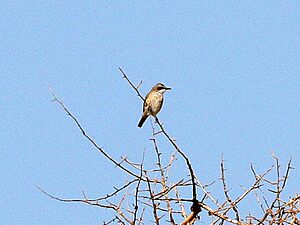Herero chat facts for kids
Quick facts for kids Herero chat |
|
|---|---|
 |
|
| Conservation status | |
| Scientific classification | |
| Genus: |
Namibornis
|
| Species: |
herero
|
| Synonyms | |
|
|
The Herero chat (Namibornis herero) is a type of passerine bird. This means it's a small bird that perches. It belongs to the Muscicapidae family. This family includes chats and Old World flycatchers. The Herero chat is the only species in its group, called Namibornis. It lives only in a small area of southwestern Africa.
Contents
About the Herero Chat's Family Tree
Scientists group living things into families. This helps us understand how they are related. The Herero chat was first described in 1931. An American bird expert, Rodolphe Meyer de Schauensee, named it Bradornis herero. He found it near Karibib in Namibia.
In 1935, another expert, R. D. Bradfield, suggested a new group for this bird. He named this new group Namibornis. He thought the Herero chat was more like birds in the Cossypha group. Today, scientists place the Herero chat within the Muscicapidae family. This means it is an Old World flycatcher. It is actually closer to the Bradornis group than Cossypha.
What's in a Name?
The name Namibornis comes from two parts. "Namib" refers to the Namib Desert. "Ornis" is a Greek word meaning "bird." So, Namibornis means "Namib bird."
The second part of its name, herero, honors the Herero people. They are a group of people who live in the Namib Desert.
What Does It Look Like?
The Herero chat is about 17 cm (6.7 in) long. That's about the length of a regular pencil. Adult birds have a black mask on their face. It looks a bit like a shrike's mask. They also have a wide white stripe above their eye. This stripe is called a supercilium. Their throat is also white.
The top part of their body is brown. Their lower back and tail are a warmer, reddish-brown color. The middle feathers of their tail are dark brown. Their belly and chest are whitish. Sometimes, these parts have a light brown tint. They might also have faint dark streaks.
Where Do They Live?
The Herero chat lives in southwestern Africa. Its home stretches from the far southwest of Angola. It goes through western Namibia. Its range reaches as far south as the Naukluft Mountains.
These birds are common in certain places. They like inselbergs and escarpments. These are isolated hills or steep slopes. They prefer areas with scattered trees and bushes. These include Acacia, Maerua, Commiphora, and Terminalia trees. They especially like places where plants grow along dry riverbeds.
What Do They Eat?
The Herero chat mainly eats insects. This means it is an insectivorous bird. Most of its food is ants and termites. They also enjoy grasshoppers, crickets, beetles, and spiders. Sometimes, they will eat berries from Commiphora saxicola plants. They also eat seeds.
They often hunt from a shady perch. They will pounce on their prey from above. Sometimes, they catch insects in the air. They also look for food on the ground. They search at the bottom of trees and bushes. They might even dig in the dirt to find hidden prey.
Life Cycle and Reproduction
Both male and female Herero chats help build the nest. It takes them about three or four days. They start by putting grass leaves into a crack or hole in a tree. Sometimes, they build it in a tree fork. Then, they add small roots, bark strips, and other plant fibers. Both birds use their bodies to shape the nest. It becomes an open cup.
Nests are usually found at the base of a tree's leafy top. This is especially true if the tree is near rocks. They also like to nest at the bottom of a slope or near dry riverbeds. The female lays eggs in February and March. Egg-laying often happens when it rains. A typical nest has two or three eggs. The female does most of the egg incubation. Incubation lasts about 16 days. During this time, the female eats many Commiphora saxicola berries.
Both parents feed the baby chicks. The chicks leave the nest when they are 12 to 16 days old. After leaving the nest, the young birds stay with their parents. They become fully independent when they are 3 to 5 months old.


